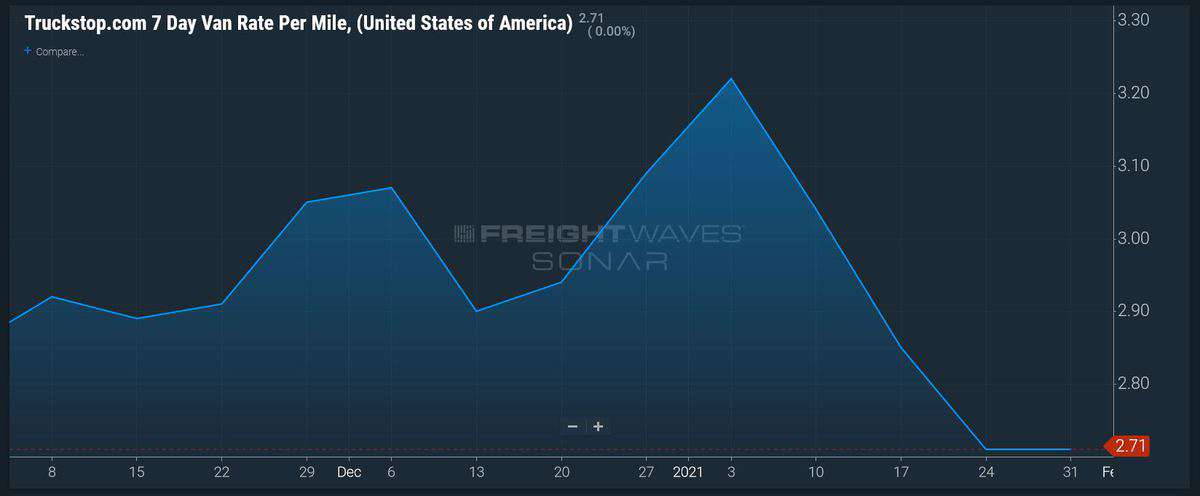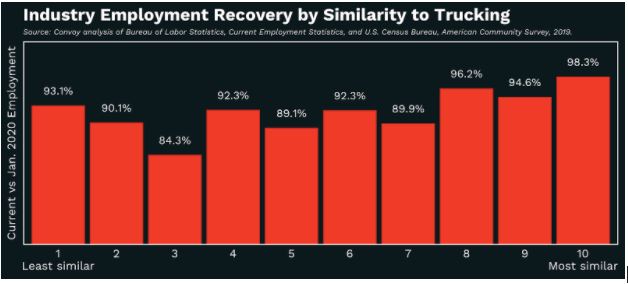The drop in the number of people employed in the trucking sector in January begs the question: Is the number of available jobs declining or is the never-ending quest to find enough drivers running into even stronger-than-usual headwinds?
In the latest employment report from the Bureau of Labor Statistics, the number of jobs in the trucking sector took a drop, the first time that has happened since between March and April of last year.
According to the BLS seasonally adjusted data, trucking jobs in the U.S. in January totaled 1,475,400. That was down from the 1,478,300 jobs recorded for December. The latest December number in turn was down from the earlier projection of December jobs of 1,484,300. (The first two months of data released by the BLS are preliminary.)
Aaron Terrazas of Convoy, director of economic research at that digital brokerage company, said he believes finding enough drivers to be seated in cabs may be a reason for the drop.
In an email to FreightWaves, Terrazas noted that if trucking companies were hiring fewer drivers, “it is not for lack of effort.”
“Compensation at transportation and warehousing firms increased 1.4% in Q4-2020 according to the Employment Cost Index published last week, the fastest quarterly increase since 2012, the fourth highest number since 2003, and double the wage increases other workers saw in Q4,” he said.
“So why are trucking firms still struggling to achieve pre-crisis levels, despite rising wages and high unemployment?” Terrazas added. “Today’s data suggest that one explanation is that the labor market for truckers is tighter than the rest of the market.”
While economists tend to look at seasonally adjusted numbers, the figures released by BLS on not seasonally adjusted jobs also showed a downturn. The not seasonally adjusted jobs in trucking plummeted more than 25,000 jobs to 1,449,400 from 1,477,300 jobs a month earlier. A year ago, January jobs were 1,522,800.
Jason Miller, a professor of logistics at Michigan State University, said the big drop in not seasonally adjusted jobs would be expected given seasonal swings. The big gap between the job drop for seasonal vs. non-seasonal, Miller said in an email to Freightwaves, “is why the seasonally adjusted employment declined by only 2,900.”
Terrazas said a decline in jobs in January relative to December is normal, coming out of the holiday season. While there is no one index of what drivers are getting paid, rates per mile did soften somewhat in January compared to December per the Truckstop.com All In dry van rate in SONAR. There also was online chatter that while rates were still strong, they had weakened relative to a few weeks earlier.

Terrazas said he studied other industry sectors and where their employment levels stood relative to pre-pandemic levels. Not surprisingly, some of the worst-performing industries included sectors like museums and historical sites, down to 75% of pre-pandemic levels, and apparel manufacturing, down to 86%.
Trucking is at 97% of pre-pandemic levels, Terrazas said, up there with some that are more than 100%, like Home Depot-type stores, and construction, at 97%. What that means, Terrazas said, is that finding workers in the trucking sector is comparable to struggles that other industries are having. “It’s impossible to avoid the reality that the labor market that trucking firms compete in for drivers has, on average, more fully recovered from the initial pandemic-induced employment decline,” Terrazas wrote. “Many industries that attract workers with similar demographics to truckers are also struggling to find workers.”

Some other highlights from the monthly employment report:
— With all the publicized pay increases in the trucking sector, the BLS data on pay continues to show some upward movement. In the NAICS sectors starting with 484, which encompasses various trucking activities including truckload and LTL, the average hourly earnings of production and nonsupervisory employees rose to $25.19, up from $25.10 a month earlier. That number is now up 72 cents per hour since September. Average weekly hours for the production and nonsupervisory employees rose to 42.3, up from 42.0 a month earlier. In September, it was 40.9, for a gain 1.4 hours per week in just four months.
— The cost of trucking is rising. The Producer Price Index for the 484 NAICS sectors is now at 151.4, up 2 full points from a month earlier. Since September, it’s up from 143.8.
— The biggest jump in pay came in the warehouse and storage sector. That hourly wage jumped 89 cents per hour in just a month, to $21.98 from $21.09. It has now added almost $1 per hour from the $21.02 posted in September. But costs in that sector only rose slightly, with the PPI rising to 110.7 from 110.6 a month earlier.
More articles by John Kingston
Truck transportation jobs gain 12,700 jobs in November
BLS’ Monaco makes clear her views on driver shortage: There is none
Truck transportation jobs grow but still below year-ago levels











